Light controller for LED lamps. What is a dimmer
You come home after a day of work, sit comfortably in the living room and read the newspaper in the bright light. Then you turn on the TV and the lights dim. And then you start to doze off completely, and the lamps turn off. How did the lighting manage to adapt to the owner’s wishes? It’s very simple - dimmers, or, in other words, dimmers (from the English dimmer - dimmer), helped.*
Where are dimmers useful?
First of all, dimmers provide visual comfort: installed instead of conventional switches, they dim the annoying brightness of the lamps to a comfortable level. Such devices are simply irreplaceable in rooms where there are several options for activities for household members:
- In the nursery, good lighting is needed for games and reading, but if the child is afraid to fall asleep in the dark, then you can use a dimmer to dim the chandelier light to a minimum;
- In the living room, bright lighting is useful for everyday activities, dim lighting for family conversations, and minimal lighting for watching a TV series;
- In the bedroom, a dimmer at the head of the bed will help create the right atmosphere in one second: from intimate to cheerfully awakening. And specialists from Legrand, a world-famous manufacturer of electrical equipment, have developed a dimmer model with a night light mode (Céliane series): over the course of an hour, it gradually dims the light and then turns it off completely. Switching to night light mode is done by pressing the three corresponding buttons.
Interestingly, dimmers not only bring convenience to the environment, but also help save up to 30% of electricity, which is quite important in the context of the constant increase in utility tariffs. In addition, dimming has a positive effect on the service life of lamps. Reducing the brightness of the lamp by just 5% extends its service life by half! This is especially true in cases where non-standard light sources are installed in the house, for which it is quite difficult to find replacements.
However, if you decide to equip your home with dimmers, it is important to understand how to do it correctly: choose the power, determine the dimmer suitable for a specific type of lamp, choose a convenient control method, etc.
Let's try to figure it out!
Each lamp has its own dimmer
The variety of lamps in modern lamps (incandescent lamps, low-voltage halogen, fluorescent, LED) imposes certain conditions on the choice of dimmers. An incorrectly selected device may simply not work with certain lamps. That is why there are devices on the market for conventional incandescent lamps and low-voltage halogen lamps (they are often used in private homes to illuminate the area), and there are also special devices for LED and compact fluorescent lamps.
True, there are also universal solutions: in particular, dimmers of the LivingLight series from the Italian company BTicino control various types of loads. The device automatically detects the type of connected light sources and adjusts its operation depending on them. There are models where switching is done manually. This is a more complex, but at the same time reliable method. Mechanical transition to different lamps is implemented, for example, in the Etika series from the Legrand Group, a global specialist in electrical and information systems buildings.
How many lights will the dimmer handle?
When selecting a dimmer, it is important to correctly assess its design power - it must correspond to the power consumption of the connected lamps. Otherwise, the device may simply not work or, even worse, burn out.
The simplest calculation is carried out for incandescent lamps: if the maximum power of the dimmer is 400 W, 10 incandescent lamps of 40 W each can be connected to it. As for LEDs and CFLs (compact fluorescent lamp), the power is taken for calculations ordinary lamp, equivalent to it in luminosity. That is, an 8 W CFL corresponds to a 40 W incandescent lamp, and a maximum of 10 such light sources can be connected to the 400 W dimmer mentioned above.
Press, rotate or slide with your finger.
Today there are several options for dimmers on the market: rotary ones, in which the lighting intensity is adjusted using a knob, and push-type ones, which use a key as a control element. For ease of use, some push elements are equipped with two buttons - one works as a switch, and the second as a regulator. For example, the Valena series dimmers from the Legrand Group operate on this principle.
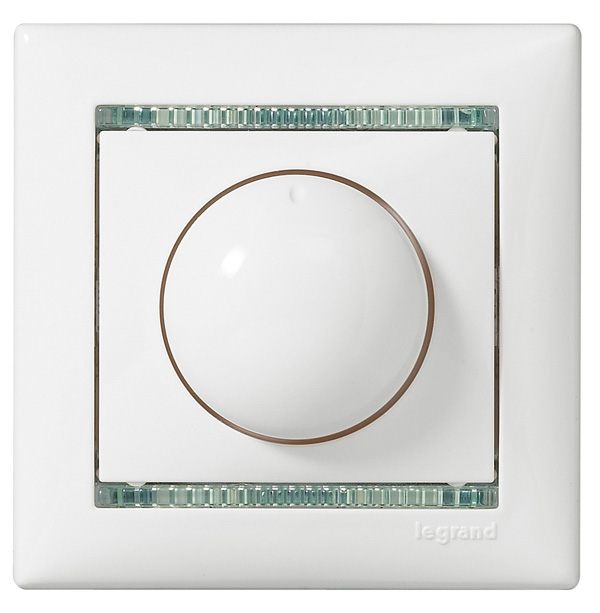
There are cutting-edge touch devices that respond to touch and its duration. And some regulators even have “intelligence” and allow you to implement various scenarios: for example, the MyHome system of the Italian company BTicino features four-key switches. With one touch, the user can create a cozy atmosphere with barely dimmed light, turn on all the illumination or switch the lamps to “night mode”. It is noteworthy that such devices allow you to control natural light by adjusting the blinds, and if desired, you can also add music to the scenarios.
Despite the apparent simplicity of dimmers, the choice of their type and design power must be taken seriously, and it is best to consult with specialists. And it will be much easier to do this now that you are armed with knowledge about dimmers. You will easily find a common language with professionals and will definitely be satisfied with your choice.
*Of course, not all dimmers are capable of this. In this case, we are talking about the ECO dimmer of the Céliane series (Legrand, France), which is installed instead of a conventional switch, and in appearance is not particularly different from it. However, it has several different operating modes that are configured during installation of the device. The user will only have to remember a few combinations of buttons to activate them. The so-called “night light mode,” which was discussed at the very beginning of this review, is activated by pressing three buttons.
Information about the Legrand company:
The Legrand Group is a global specialist in electrical and building information systems. Legrand products are used in residential premises, administrative buildings, and industrial facilities. The company produces more than 215 thousand types of products and has more than 4.5 thousand active patents for inventions. The Legrand Group unites 36,000 employees operating in 80 countries. Among them are France, Russia, Italy, Germany, Spain, USA, China, Australia, etc. The company's offices are open in 22 cities in Russia, Kazakhstan, Azerbaijan, Uzbekistan, the Republic of Belarus and Ukraine.
Lighting of completely different rooms or areas can be done through a special device called a dimmer or lighting brightness controller. This device allows you to adjust the power of the emitted light smoothly or stepwise. Using a dimmer, you can change not only the brightness of the lamps, but also reduce the cost of electricity.
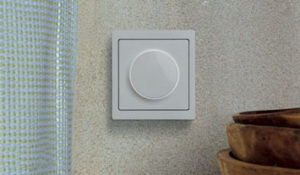 Since the lower the luminous flux, the less this light source consumes power from the network, which means that the mode of saving electrical energy occurs. If we look at a dimmer for incandescent lamps from this perspective, it is clear that as the brightness changes, the current passing through the tungsten filament also changes, which increases the service life of incandescent light bulbs, which are already considered obsolete.
Since the lower the luminous flux, the less this light source consumes power from the network, which means that the mode of saving electrical energy occurs. If we look at a dimmer for incandescent lamps from this perspective, it is clear that as the brightness changes, the current passing through the tungsten filament also changes, which increases the service life of incandescent light bulbs, which are already considered obsolete.
The device for changing the brightness of the lighting can be equipped with a circuit breaker, such devices are called. Their use is very convenient since with one turn you can turn the lighting on or off, while also adjusting its brightness very smoothly. Most often, it is equipped with a mechanism that is felt when you turn the dimmer control in the form of a click. Dimmable lamps are very effective in implementing various design solutions. Even ordinary table lamps, turned on via a regulator, can already become night lights. An LED lamp with adjustable brightness will make your home cozier and more comfortable in the evening.
What types of dimmers are there?
Initially, such electrical devices could only be controlled by mechanical action, and their main function was only to change the brightness of the light flux sources, with the development modern technologies, dimmers and dimmers have reached a whole new level. Modern dimmers are multifunctional devices designed for a number of actions:
- Changing the brightness of lighting;
- Smooth switching off or switching on of lighting;
- Creating the effect of presence by turning on the lighting when the owners are not at home for a long time;
- Supports multiple dimming or flashing modes;
- Acoustic control.
Dimmer for LED lamps 220v and others, either a single regulator or light switch or a group one is installed. All existing dimmers can be divided into two main groups according to the control system: 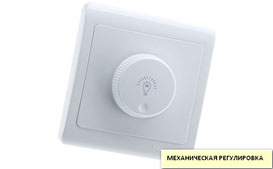
- Mechanical rotary-push (adjustment is carried out either by rotating the brightness wheel or by buttons);
- Electronic.
In its turn, electronic devices for adjusting illumination are divided into:
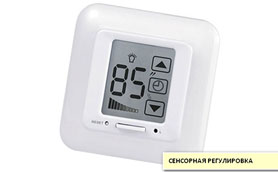
Connecting a dimmer to various light sources
To create modern lighting, three main types of light sources are used:
- Lamp "Ilyich");
- Gas discharge, inside the flask there is a gas of high or low pressure;
- A light-emitting device based on a semiconductor device - LED.
Adjusting the brightness of an incandescent lamp is considered the simplest and can be done simply on the basis of a variable resistance or a potentiometer, since turning on such a lamp does not require a ballast or voltage converter. A resistor is connected in series with the lamp. The disadvantages of the system are the large currents passing through it, which causes the contact of the adjusting resistance to deteriorate. This method changes the current in the lamp circuit, but you can change the voltage for this, of course, you can use an autotransformer, but this will be a very non-compact device and therefore is considered only theoretically.
Fluorescent or other gas-discharge light sources require special electronic ballasts for their operation and startup. Here an integrated approach to regulation is already being implemented, that is, an electronic ballast and a dimmer are combined in one set. The same goes for brightness adjustment. energy saving lamps, since, in essence, these are the same fluorescent lamps only compact. Some HID lamps have a dimming threshold that does not exceed 50% due to insufficient voltage to maintain the electrical charge in the lamp.
Adjusting the glow of an LED lamp is carried out by adjusting and changing pulse-width modulation (PWM), in which the LED is powered by a pulsed current. Therefore, before the current can be regulated, it must be immediately converted from alternating to direct. There are also special LED lamps for dimmers, which are undemanding in terms of the adjustment method and the device itself.
When purchasing any lamp with any light source, and a dimmer for it, you should consult with the seller in the store; it is also advisable to check it by connecting it to the network and see with your own eyes that everything works properly. Since the professionalism of the sellers may not be adequate.
How does a dimmer work?
If what a dimmer is is clear, then it is now worth considering a dimmer for gas-discharge lamps and a dimmer for LEDs. An LED is a semiconductor device that is powered only from the mains DC voltage, so to straighten it you need a driver (power supply), which is already built into a regular LED lamp. Adjusting or dimming an LED lamp in no way reduces its uninterrupted operation time, and at the same time it is possible to reduce energy costs.
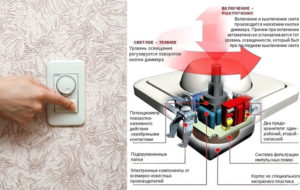
PWM-based dimmers are quite compact and efficient. They are perfectly implemented on microcontrollers; this provides the device with additional useful functions. That is, a person not familiar with electronics needs to understand that not all LED lamps can be adjusted through a regular regulator; a special dimmer is needed specifically for this device. Or a source based on an LED with the ability to connect to the most common dimmer.
Dimmer for LED strips
LED strips are designed for a voltage of 12 volts, so when connected to a 220 volt network, in addition to the brightness control, it must also include a step-down power supply. The tapes are perfectly regulated by special devices, of which several hundred can be found on the modern equipment market. In this case, the brightness of the tape is adjusted almost from scratch and almost always remotely based on either a radio signal or infrared. With the help of an LED strip, even a simple table lamp or chandelier can become a masterpiece.
Connection diagram and how the dimmer works
It is worth noting that this circuit diagram Only works with dimmable LED lamps. When the variable resistor knob is rotated, the current in the triac control circuit changes, due to which the adjustment occurs AC voltage, supplied in an LED lamp.
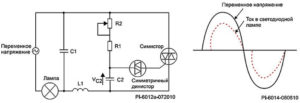
If you are using LED lights ceiling ones, then the entire adjustment mechanism is designed in the switch or next to it.
How to choose a dimmer for LED lights and lamps
If you consider ready-made dimmers for LED lamps, you need to immediately pay attention to the packaging box itself. If it is indicated at the time of purchase that dimmable LED lamps have this function, then it can be connected without problems to a regular dimmer for incandescent lamps. The main thing is to choose so that the power of the lamp matches the power of the regulator. The situation is worse and more complicated with non-dimmable light sources based on LEDs. Adjusting the brightness is possible only with special devices, either made manually or specially purchased in a store, however, their price is quite high, so it is better to take the simple path and choose a lamp whose packaging specifically states that it can be connected and adjusted through a regular dimmer .
Video about choosing a dimmer
Many people today still do not know what kind of device a dimmer is. In this article we will try to give a comprehensive explanation, and also consider several diagrams for its connection.
There is a large selection of dimmers on the shelves of lighting stores. This device is designed to smoothly control the brightness of lighting, and is most often installed instead of a conventional switch.
Dimmers are classified according to several parameters. Let's take a closer look at them.
Type of execution
There are three types of dimmers:
- Modular devices are installed in switchboard. They are used to turn on and adjust lighting in public places: corridors, entrances, stairs;
- The dimmer with the switch is installed in a special box, in which the socket is usually mounted. The control is usually a button;
- A monoblock dimmer is installed instead of a switch. Therefore, problems with how to install a dimmer of this type most often do not arise. Due to its popularity, it has received several subspecies, differing in the method of management.
Control type
Monoblock dimmers used in everyday life are available with several control options:
- Rotating devices are equipped with a rotating handle. The extreme left position turns off the lighting, and when you turn the knob to the right, the brightness of the lamp increases;
- Rotary-push dimmers have the same operating principle. The difference is that to turn on the light, the handle must be slightly recessed;
- The key device completely copies the appearance of a two-key switch. In this case, one key is responsible for turning the lighting on and off, and the other regulates its brightness.
Recently, touch dimmers have appeared and quickly gained popularity due to their modern appearance. Such regulators fit perfectly into any interior, especially if it is made in high-tech style. Dimmers with remote control are deservedly considered the most convenient. The remote control allows you to adjust the brightness of the lighting from anywhere in the room. Some models also have a switch function.
Type of adjustable lamps
It may seem strange at first glance, but different regulators are used for each type of lamp. First of all, this is due to the variety and design features of modern lamps.
For incandescent lamps, the simplest dimmers are used, the operating principle of which is extremely simple: by changing the voltage, the brightness of the filament is adjusted. In addition, this dimmer is suitable for halogen lamps operating at a voltage of 220V. It is worth noting that the circuit diagram of this dimmer is not complicated.
To adjust the brightness of halogen lamps operating at 12 and 24V voltages, dimmers are used, the design of which is somewhat more complicated. An ideal dimmer circuit should include a step-down transformer. If this is not possible, you need to select a regulator depending on the transformer used. For a winding transformer, an adjustment device marked RL is used, and for an electronic transformer, it is marked C.
For LED lamps, a special type of dimmer is used that uses pulse modulation of the current frequency.
The most difficult thing is to adjust the brightness of fluorescent or energy-saving lamps. Some experts believe that dimming such a lighting network is inappropriate. But if you want to regulate the brightness of energy-saving or fluorescent lamps, then the dimmer circuit must include an electronic ballast (electronic starter).
Advice! When choosing a dimmer, you need to take into account not only the type of lamps for which the device is intended, but also the maximum design load. It is also recommended to choose a dimmer model with power reserve.
Connection options and diagrams
There are several options for connecting a dimmer to a lighting circuit. Let's look at the most used of them.
Option #1
The easiest way is to install a dimmer instead of a switch. Before dismantling the key switch, the circuit must be de-energized. After this, you need to remove the key cover: the mounting screws are located under it. If there is no plastic box installed in the socket, then after removing the breaker, it must be installed. You can take a regular box that is used for an outlet.
A monoblock dimmer is connected in the same way: a phase wire is inserted into the gap. It is connected to the terminal with an upward arrow and the letter L. The second wire is connected to another terminal, indicated by an inclined arrow and a wavy line.
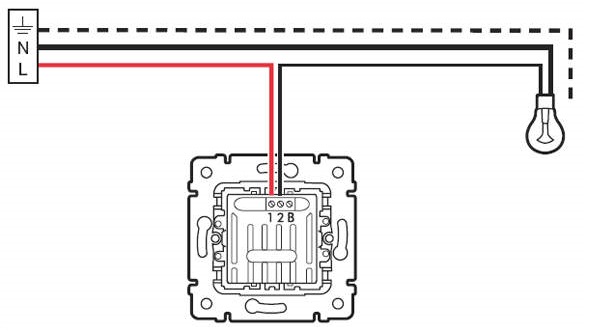
Let us note once again that this is the easiest way to install a dimmer, so it is most often used by home craftsmen, since it does not require special skills. It is practically no different from the technology of replacing a switch or socket.
Option No. 2
A more complex, but at the same time more convenient scheme is used in bedrooms. Its essence lies in the fact that the switch and regulator are connected in series, to one phase wire going to the lamp. In this case, it is important that the breaker is first installed on the line, and then the dimmer. The most common option is to install a switch near the door and a dimmer near the bed.
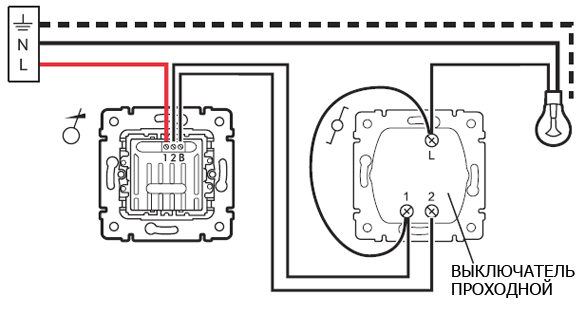
The advantage of this method is that you can adjust the brightness and turn off the lights without getting out of bed. If you turn off the light with the switch when leaving the room, then when you turn it on again, it will burn at the same brightness level as was previously set.
Installation of a pass-through circuit breaker
Perhaps the most difficult option is the option if you need to install a pass-through switch. Despite its installation complexity, this scheme is very convenient and is often used in long corridors, interfloor staircases, through rooms, and other similar places. The essence of this method of lighting control is that by turning on the lamp in one place, it can be turned off in another.
In order to realize the possibility of installing a pass-through switch, you need to lay a three-core cable up to two switches.
Note! If the circuit involves the presence of three or more switches, then a four-core cable must be laid to them.
The peculiarity of pass-through switches is that they are rather switches. In fact, they switch from one line to another, so they can be turned on in any key position. This is very similar to railroad switches. Below is a schematic diagram of where the pass-through switch is installed.
As you can see, the phase comes to the first breaker, and goes to the lamp from the other. The switches themselves must be connected to each other using a two-wire wire.
Advice! The feed-through circuit breakers are not connected directly. This is done through a junction box, where the wires are connected in pairs.
Now let's look at how a dimmer works in such a circuit. It is connected after the last pass-through switch and allows you to easily adjust the brightness of the lighting at any position of the breakers. But if you put it in the “off” position, the light will go out and will not respond to the pass-through switches, since the circuit will be open.
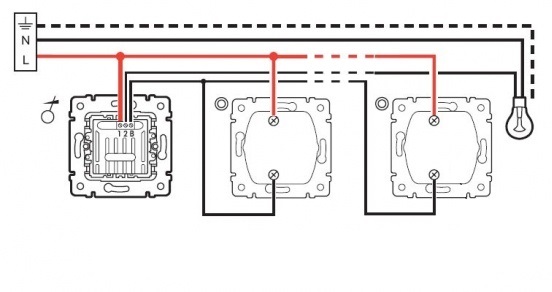
Dimmer - what is it? First of all, this is a dimmer or variator that changes the output voltage according to the rheostat principle and serves to smoothly change (dimming) brightness of lamps of various types: incandescent, LED, by changing the input voltage. A mechanical dimmer is a convenient type of light switch with advanced functions. You just need to remember that it is unacceptable for some types of lighting: metal halide, fluorescent and energy-saving lamps. Chokes are supplied with the dimmer; this is done to prevent the appearance of high-frequency interference and noise during the operation of the device.
What types of dimmers are there?
There are several types of dimmers according to the way they perform regulation:
- Mechanical.
- Sensory.
- Acoustic.
- Remote.
By design features:
- Modular device. Installation of such a dimmer is carried out directly in distribution board, the device can work with lighting systems using incandescent lamps, as well as halogen lighting devices equipped with a step-down transformer. Control occurs via a single-key or push-button switch.
- Dimmer installed in a mounting box. Installed simultaneously with the installation of electrical wiring, can be used with halogen lamps with step-down or electronic transformers.
- Monoblock dimming device. Performs the function of a switch, the installation feature requires a two-wire connection, to be made into a break in the phase wire of the circuit going to the load.
- Rotary-push monoblock dimmer, turns on when you press a key, brightness is adjusted by rotating the key.
- Rotary dimmer. Turning on and controlling the brightness occurs by rotating the button; turning on always occurs from the lowest brightness level.
- Key dimmers differ in adjustment, it is carried out by holding the key.
- Touch devices, adjustment occurs by touching the sensors.
One of the types of dimming devices that can be mentioned separately is a surface-mounted dimmer. Can be used as aesthetic and decorative control electrical accessories on the wall surface, for example, for walls lined with ceramic tiles, due to the variety of materials used: ceramics, silicone, plastic, etc.
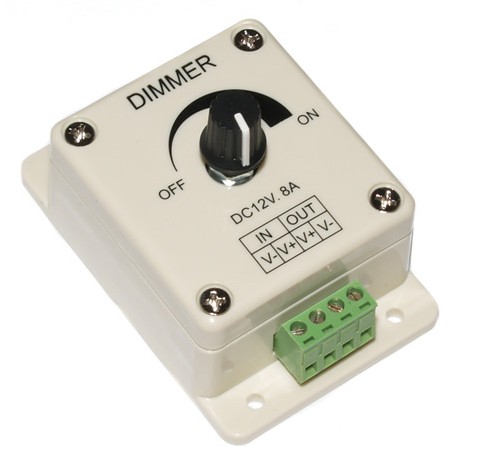
There are several tricks that are typical for arranging lighting systems. One of them is to use a pass-through dimmer. This installation consists of installing a mechanical dimmer to adjust the brightness of lighting from opposite corners of the room; the most convenient decision was to use a pass-through dimmer in the amount of 2 pieces connected in parallel, with each device adjusting the half-cycle associated with it. When one device is fully activated, the second does not participate in regulation.
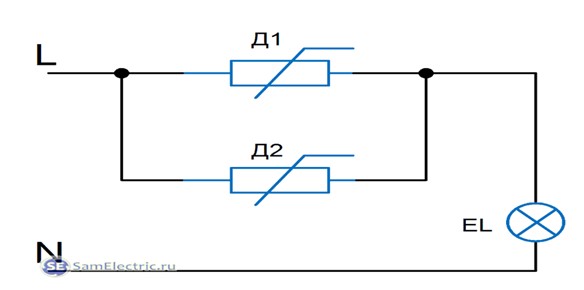

The best solution for this issue may be to use a touch dimmer, when using two such electronic devices synchronization can easily occur. A good solution for a pass-through dimmer can be found using the Fibaro micromodule model FGD211 or FGB-001.
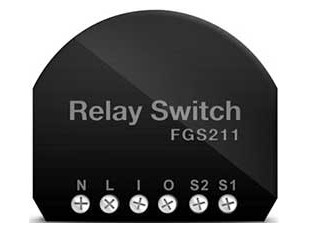
LED dimmer
A dimmer is suitable for adjusting integrated LED lamps. Bypass FGB-001 or dimmer Busch-Dimmer® LED. Dimmers of this type are suitable for use with both halogen and energy-saving lamps for which conventional mechanical devices are not suitable.
The touch dimmer allows you to adjust the power of lighting fixtures in accordance with your own needs and remembering the last connection; control is carried out using a touch device and via remote control via an infrared port. The device uses transistor technology.
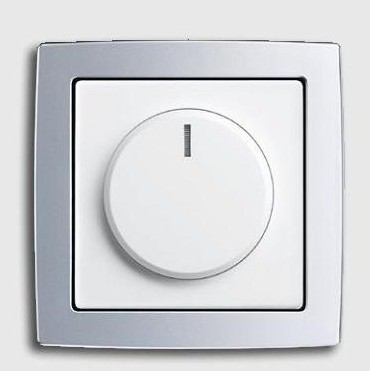
Dimmer operating principle
The operation of the device is based on the use of phase adjustment, due to cutting off the leading or trailing edge of the wave alternating current using a bidirectional thyristor, using pulse-width modulation, that is, changing the voltage supply to the lamp within the widest limits. Triggering of the thyristor activates the load signal with a delay when fully turned on - 0, and with a maximum decrease in brightness - 9 ms.
How does a dimmer work?
Dimming is carried out using “phase cut-off”, in which one part of the sinusoidal voltage in the network is cut off, and the effect that supplies the voltage to the lighting is reduced. If the cutoff action is applied at the beginning of the sine wave, the technique is called “rising edge dimming”; if the technique is applied at the end of the sine wave, the technique is called “falling edge dimming.”
These methods are used to dim different types of lamps: “Falling edge dimming” is recommended for low voltage LED or halogen lamps using electronic transformers. "Leading edge dimming" is used for low voltage lamps using electromagnetic type transformers, as well as for 230V compact fluorescent and LED lamps. These two methods are also well suited for halogen lamps and 230V incandescent lamps.
Stable operation of the device forces the use of a wire with three cores, one for grounding, for working zero and for phase; this action is used to maintain the zero crossing point. When using small dimmers, a two-wire wire is sufficient.
Universal type dimmer device
![]()
The dimmer device has several protections - this is protection against overheating, it is triggered by turning off the device and it can be turned on again only after it has cooled and only manually, it works when the load is connected.
Short circuit protection, in which case the output where the short circuit occurred is turned off. In this case, operation occurs in phase cutoff mode; the absence of a malfunction for 7 seconds causes the device to turn on in automatic mode; if more, then it can only be turned on manually.
The device also has terminals for connecting wires and a light level regulator.
Share useful material on social networks
A dimmer is a device designed to regulate the brightness of lamps. In simple words, a dimmer is a lighting controller. Let's imagine a situation where the same room is intended for both work and relaxation. For example, when working in the living room, anyone will need brighter lighting than when watching TV. In the second case, the consumer would prefer a much more dim light. In order to be able to regulate the brightness of the same light sources, and not install additional ones, use a dimmer. The device, in addition to convenience, allows its owner to save a significant amount of electrical energy, as well as extend the life of light sources. In this article we will tell you how to choose a dimmer based on power, design and type of lamps.
Bulb type
It is important to remember that there are dimmers that are suitable for a number of specific types of lamps, but there is no universal dimmer. The choice of dimmer should be made depending on the type and power of the light bulbs.
As is known, there are different kinds light sources, including incandescent lamps, LED, halogen, fluorescent, LED modules, strips and rulers. At the same time, dimmers can be used in absolutely all types of lamps: for chandeliers, sconces, floor lamps, pendant lamps, as well as for spotlights. Let's look at each type of light source separately.
Choosing a dimmer for incandescent lamps is much easier than for other light sources. Another advantage is the ease of its connection: it can be installed instead of an ordinary switch. But it should be noted that by reducing the brightness of an incandescent lamp using a dimmer, the color of its glow will also change and become more red.
As for fluorescent lamps, choosing a dimmer for them is almost impossible. Theoretically, this event is possible, but subject to the creation of a complex technical system with the additional use of an electronic ballast and controller. In this case, the dimmer itself will differ from that used for incandescent light bulbs.
Choosing a dimmer for energy-saving lamps, that is, for compact fluorescent lamps (CFLs), is somewhat simpler. If the CFL already has a built-in ballast (ballast), then this light bulb can be easily dimmed using a conventional regulator. In the absence of ballasts, it will be dimmed with the same difficulty as a conventional fluorescent one, which is very labor-intensive and costly.
For halogen lamps, choosing a dimmer is very simple. In this case, you can use a regulator for incandescent light bulbs, or purchase one specifically for this type of product. You should pay attention to the voltage from which the halogen lamp operates. If we are talking about a voltage of 12V, then it is necessary to use a step-down transformer.
Selecting a dimmer for devices based on the use of LEDs is more difficult. For 220V LED lamps, choosing a dimmer is very simple. The packaging usually indicates whether the model is dimmable or not. If the marking indicates that (as in the photo below), then the regulator can be used as for ordinary light bulbs. LEDs can also be controlled using a remote control specially designed for this type of lighting source.
When choosing a dimmer for 12 V LED lamps, you should not forget about the use of a step-down voltage transformer, as well as the use of a special controller. To choose a lighting controller for LED modules, strips and strips, you also need to pay attention to the voltage from which these devices operate. Usually this is 12V, and as mentioned above, their operation requires the installation of additional devices, including a controller and a special intelligent control panel.
To make it easier for you to make your choice, we recommend studying the following algorithm in the table:

Power
It is also important to choose the right power dimmer. In order to select a suitable dimmer, you need to determine its rated power. To do this, the total power consumption of the connected lamps is calculated. If you choose the wrong parameters for the lighting controller, it may not work, or, conversely, it may immediately fail.
To understand what power the light bulbs have, just look at the packaging; all the parameters should be indicated on it, which is what you need to start from when choosing a dimmer for your home or apartment. If there is no packaging, then carefully examine the lamp itself; high-quality manufacturers indicate the characteristics of their products on the body.
Important point— when choosing the dimmer power, be sure to take into account the margin, at least 20%, but better than 50%. For example, if the total power of the light bulbs in the lamp is 100 W, the regulator should be rated at 150 W.
Execution option
Well, the last thing I would like to talk about is how to choose a dimmer model. Today, there are not only classic rotary dimmers, but also keyboard, rotary-push and even touch-sensitive ones. In addition, lighting controllers can be modular (for installation in a distribution panel), monoblock (standard) or for hidden installation in an installation box. Let's briefly consider the features of each design option.
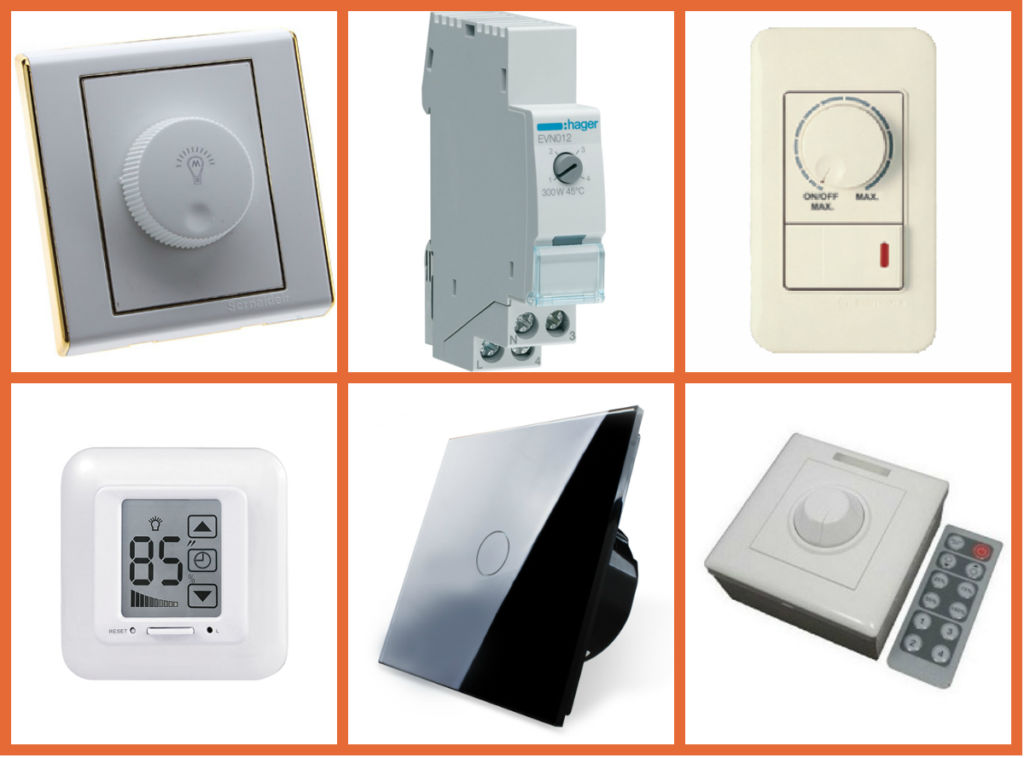
The rotary-push light controller is capable of remembering the settings (set lighting level), because turning on and off is carried out by pressing the rotary knob, through which the desired brightness of the lamps is adjusted.
Keyboard models work a little differently - the light is adjusted by holding the key itself for a certain time (usually 3 seconds). An equally convenient option for controlling light.
Well, modern touch-sensitive models adjust the brightness of the light bulbs by touching the sensor with your finger. It’s very convenient, but you’ll have to pay significantly more for a touch dimmer, so it’s up to you to decide whether to choose this option or whether it’s better to give preference to the classic model.














